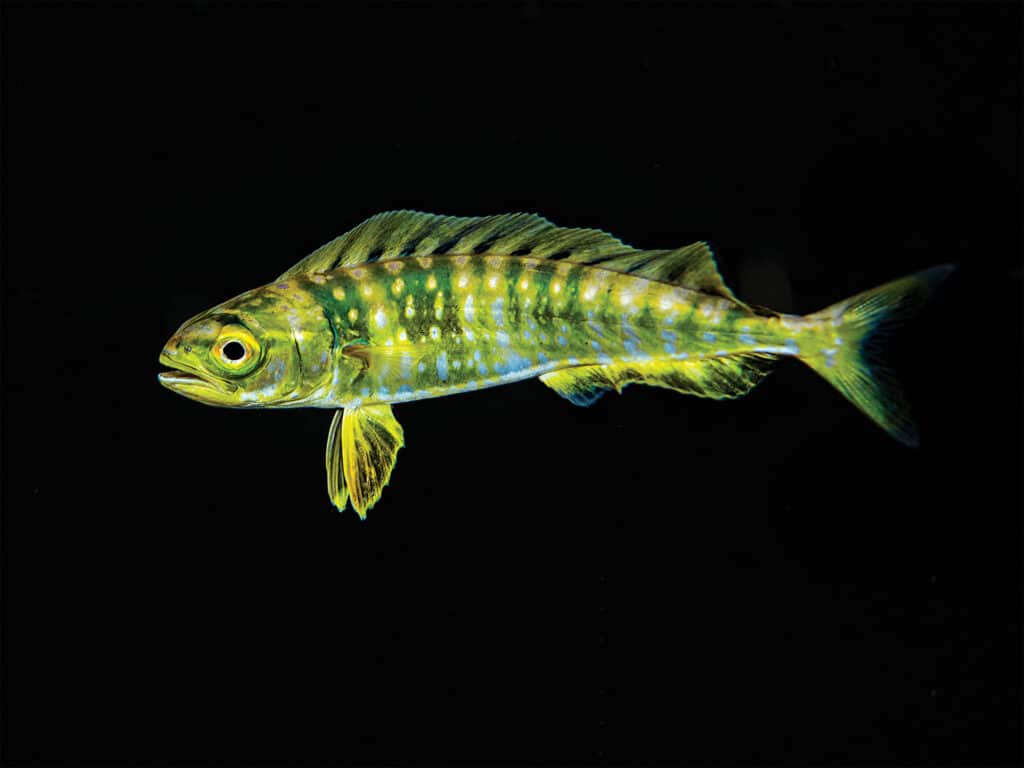
Thank God for the mahi.
It never fails. When someone learns that I’ve fished all over the world, they immediately ask me, “What’s your favorite fish to catch?” Lucky for me, the mahi makes this easy. Naming Coryphaena hippurus is almost a no-brainer.
Does any other gamefish species tick as many boxes? These amazing critters are:
- Abundant in all warm and temperate oceans
- Aggressive and usually eager to strike most baits or lures
- Great sight-casting targets in blue water
- Fabulous high-jumpers, leaping at the first sting of a hook
- One of the fastest fish in the sea
- Unforgettably and incomparably colored, with ever-changing brilliant electric blues, yellows and greens
- Fast-growing, reaching 2 to 4 feet in length in a year
- Among the finest-eating of fish
In part because the species is so widespread, C. hippurus is a fish of many names. But it most frequently goes by three: dorado in South and Central America and California; dolphinfish (often just dolphin) in the Southeast US and Caribbean; and mahimahi or simply mahi in Hawaii and most areas outside those mentioned above. Whatever you call it, mahi remains one of the world’s most popular gamefish.
Mahi occupy the surface layer of the deep ocean, swimming in large schools when young and in small packs as they grow into large adults. The largest mahi can patrol the sea solo but sometimes gather in numbers around anything that passes for a FAD (fish-aggregating device). Mahi may hang around any piece of flotsam for long periods, often in schools of dozens, eager to compete to run down anything that moves.
Recently, internationally known marine artist and conservationist Guy Harvey and mahi scientist Wess Merten came across a huge floating tree.
“We tagged and released 30 gaffers in six hours off Tropic Star Lodge (in the Pacific off southern Panama),” Merten told me. He says they left the fish biting and could have caught many more, had they wished. Smart anglers know to check out anything they spot on the open sea.
According to IGFA records, the largest mahi caught per IGFA standards is an 87-pound bull in the Gulf of Papagayo off northern Costa Rica’s Pacific coast in 1976. Larger mahi may exist, but none have yet to defeat that record, caught nearly a half-century ago.
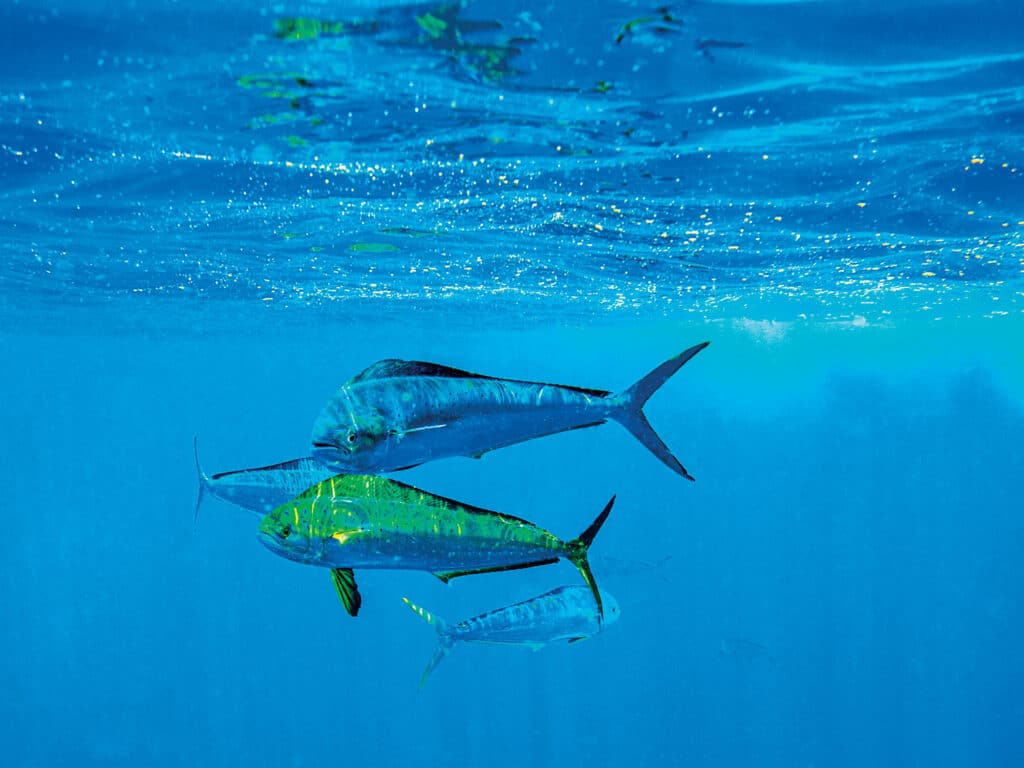
Life in the Fast Lane
“Live hard and die young” could be the species’s mantra. Studies show daily growth rates of 0.1 to 0.16 inches per day. Granted, that was measured in captive fish, but that rate of growth, if sustained for a year, would grow fish of nearly 3 feet to more than 4 feet in length.
Most mahi die within a year or two, if they make it that far. They mature in four or five months (and can spawn at just 8 inches in length). The frequency with which mahi spawn is awesome. Large adults can spawn several times a week and might spawn several million eggs in total.
Because mahi are generally found in open water, they make great targets for light tackle, which, in my estimation, is the way to target them. On heavy lines trolled for billfish, mahi are often simply cranked in. The same fish on light braid will offer a thrilling performance. Mahi can offer serious fly-rodders a great challenge as well; in January 2007, Gary Carter bested what is currently the men’s 2-pound-test tippet record on fly with a 58-pound, 3-ounce mahi.
Mahi that large—in fact, more than 35 to 40 pounds—are often bulls, evident because adult mahi are sexually dimorphic. Although the sexes appear identical when young, females remain more slender, with a smooth, sloping forehead as they mature. Males—the bulls, which always grow larger—develop a distinctive squared-off forehead that gives them an almost menacing appearance.
Anyone who’s seen mahi chase down a bait, lure or fly can attest to just how quick they are. In fact, many sources put their top-end speed at 50 mph or more. California Sea Grant says mahi have been clocked at 57.5 mph.
Although some large mahi have been recorded via satellite tags to dive to as much as 860 feet, mahi generally remain near the surface. Mahi definitely prefer warm water, being most active in waters 80.6 to 82.4 degrees F. In more northerly parts of the species’ range, anglers look for mahi seasonally when the offshore water warms into the 70s.
Since 2002, more than 31,000 mahi have been tagged and released by thousands of anglers participating in the Dolphinfish Research Program, an international tagging program for the species. Though much remains to be understood, 781 recaptures and 66 satellite tag deployments have led to scientific descriptions of movements, diving behavior, population structure, growth and oceanographic preferences.
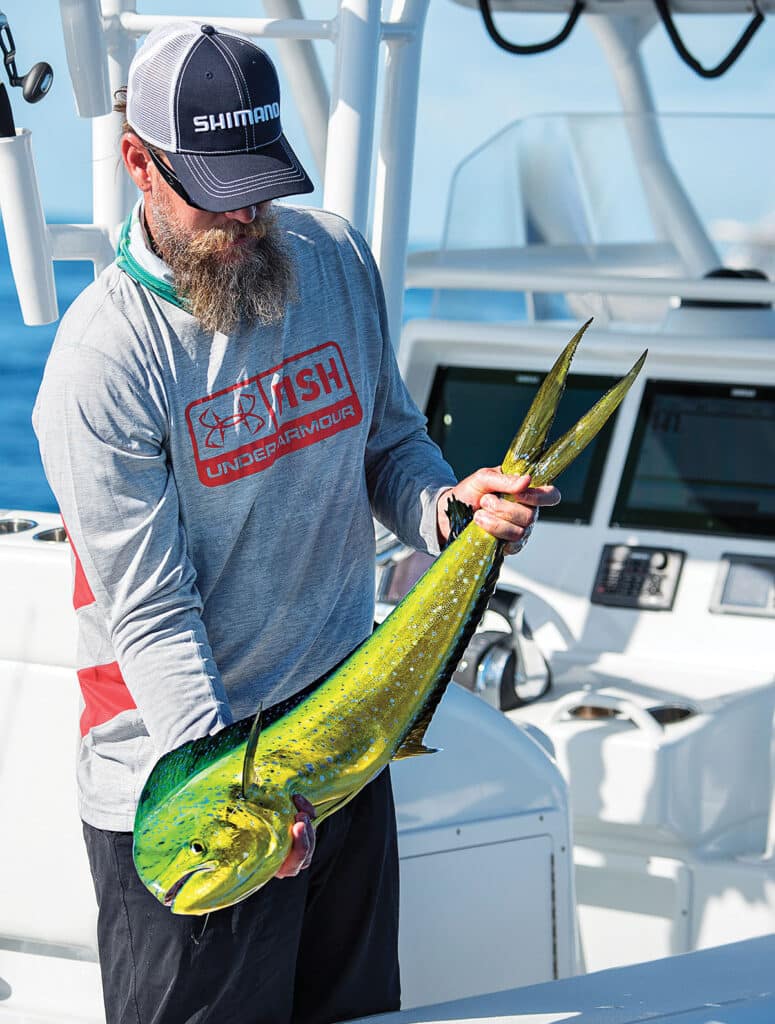
Mahi Matter
The importance of mahi to local coastal economies in the Southeast US, and particularly South Florida, runs deep, says Capt. Ray Rosher. One of Miami’s best-known and respected skippers, Rosher says: “They’re extremely important to the charter fleet because it’s a fish we can encounter year-round. That’s a huge asset, especially when other types of fishing are slow.”
The species, found on both coasts, has been valued at $450 million to the US economy.
Given their abundance and meteoric growth rate, it’s been widely assumed that mahi populations are beyond concern. And while anglers in many regions report that stocks of the species do seem as robust as ever, South Florida fishermen have begun sounding an alarm bell. In the past five years, the decline in numbers of their beloved dolphinfish has become glaringly evident. Where mahi used to be a sure thing for bluewater boats much of the time, these days charter skippers and private anglers are lucky to run into them. No scientific study needs to confirm that numbers of the popular fish are way down.
“There’s general agreement that the [dolphinfish] fishery has fallen off in Florida quite a bit in recent years,” says John Hadley, an economist, fishery management plan coordinator and staff contact for the Dolphin Wahoo Advisory Panel that reports to the South Atlantic Fishery Management Council.
In fact, the dolphinfish catch around the Southeast has been dropping for a quarter of a century or so, per federal landings estimates. Between 2015 and 2020, recreational landings plummeted from about 3 million to 1 million pounds. The commercial fishery experienced a similar decline.
On the other hand, landings in some adjacent areas increased. For example, catches in the Dominican Republic increased by a factor of 2.3 (from 199 metric tons in 2015 to 460 metric tons in 2019).
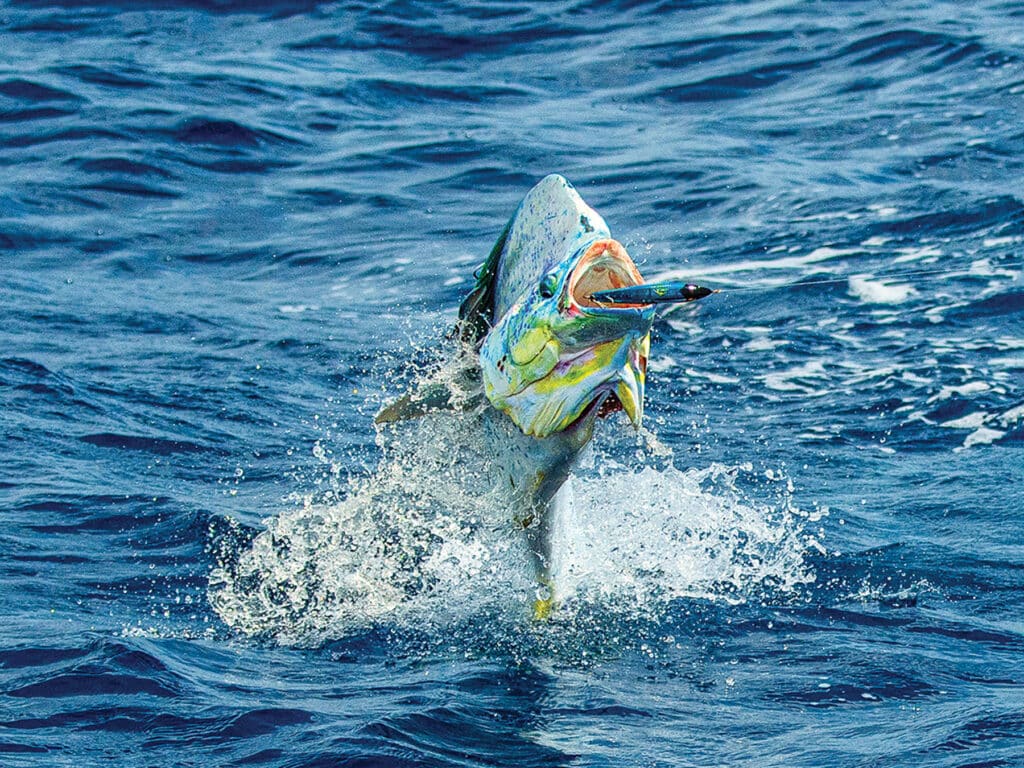
Where Have All the Gaffers Gone?
Overall, problems exist throughout the western central Atlantic, says Merten, director of the Dolphinfish Research Program (dolphintagging.com) and Beyond Our Shores Foundation (beyondourshores.org). He cites population-estimate work using longline data showing the abundance of mahi. “I think you could say dolphinfish are in trouble,” he says.
But concern over mahi availability isn’t uniform throughout the range of this oceanic nomad. “The Carolinas still have a pretty healthy dolphin fishery,” says Chris Burrows, a North Carolina native who has served on the Dolphin Wahoo Advisory Panel since 2010 and is currently its chair. His words help explain why the clamor to clamp down on the harvest of mahi has been minimal off the mid-Atlantic. Burrows says his “charter guys still get good catches of dolphin.” But then he hits upon an ostensible crisis that appears pervasive in all regions: the size of the fish most often encountered. “We’re not getting the big gaffers we once caught,” Burrows explains.
That’s the case for the US East Coast generally, Hadley says. “The quality of the fishery has gone down,” he says, with trophy-size mahi few and far between.
Federal regulations currently allocate 24.5 million pounds of mahi annually for total harvest (an allotment far from being met). About 93 percent of that is allocated for recreational use, with 7 percent for commercial fishermen.
Are Limits Too Generous?
While there’s widespread acknowledgment of a growing problem with mahi populations, its cause and solutions are all over the place. According to some, the blame lies in recreational fishermen harvesting too many mahi. Current SAFMC regulations for federal waters allow anglers 10 mahi per day with a 54-fish boat limit and, south of North Carolina, a 20-inch fork-length minimum.
Is that too generous? Absolutely, say many South Florida anglers, who would like to see the bag limit halved. And that, in fact, is exactly what the state of Florida has done: As of spring 2022, the dolphin bag limit in state waters was reduced from 10 fish per day to five. While a boat in federal waters may keep 54 fish, the daily vessel limit in state waters is now 30 fish, making Florida the only state to diverge from federal regs.
That may be of limited help because the great majority of mahi are caught beyond state waters, but it’s of symbolic importance as a reminder of how many boats in this region chase and rely on mahi as a gamefish.
But farther north, where numbers of mahi seem to be holding up, no such bag-limit-reduction effort has occurred. Generally, sport-fishing interests there are happy to keep boat limits at 54 fish (down from 60 until this year, a small concession) and not institute a minimum size. Regarding the latter, Burrows says of mahi brought in to North Carolina docks: “The average size is around 23 inches. Very few captains keep fish less than 20 inches,” though they could legally, he adds.
Some involved in fishery management have called for uniform regulations for mahi off all states where they’re found. Merten points out that while that uniformity in minimum-size regs—which we don’t have now—could allow an increase in spawning biomass of mahi in the system generally, regional variances in size and bag-limit rules could also work. In fact, the Caribbean Fishery Management Council has moved to separate island-based fishery-management plans for species like mahi.
Read Next: Pot-Hopping for Mahi
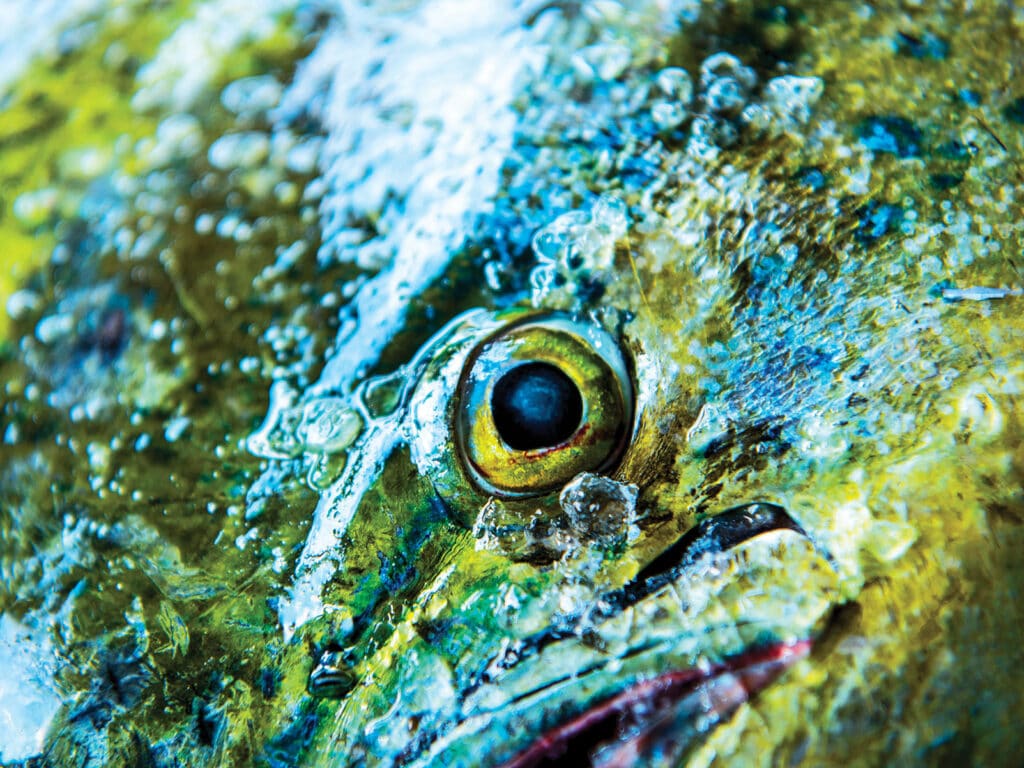
Too Little Known, East and West
Though knowledgeable recreational interests understand that the commercial harvest is not allowed to exceed 7 percent of the total mahi allowable catch, there has been some grumbling about the commercial harvest, particularly focused on longliners. After extensive bottomfish closures from 2006 to 2009, some of those fishermen “found out pretty quickly that it isn’t hard to get an operator’s card and go out and longline dolphin when they become thick in the spring off North Carolina,” Burrows says, noting that vessels permitted for non-HMS (highly migratory species) can legally longline with few restrictions.
Certainly, there’s greater concern and debate among fishery managers about mahi populations in the western Atlantic than ever. The biggest roadblock to making smart decisions, Merten says, is the lack of data. Unlike mahi, the stock status of yellowfin tuna and blue marlin has been assessed many times. In other words, it’s all about economics. As popular as mahi are among anglers, they’re not a species highly valued enough to warrant accurate estimates of their numbers, which is the root of the problem.
The US has limited data, but it’s still more than most other countries. Merten says that 23 western Atlantic nations known to catch mahi still don’t report landings of them. The International Commission for the Conservation of Atlantic Tunas, responsible for the management of tuna and billfish in the Atlantic, simply lumps mahi under “other fishes” as part of the commercial bycatch.
“This designation,” says Merten, in an article published in Marine Policy, “effectively removes any ICCAT priority to determine the impact on the Atlantic dolphinfish stock, leads to lower-quality data collection on both indirect and direct dolphinfish fisheries throughout the region, and eliminates the opportunity to seek conservation measures if necessary.”
Like mahi in the western Atlantic, C. hippurus populations in the eastern Pacific are little understood. But there are differences in the species’s fishery between oceans, Merten says. He notes that commercial fishing plays a much larger role in the eastern Pacific. While some of that is from artisanal longliners, big purse seiners on the high seas indirectly catch mahi too.
Merten says his experience with phenomenal numbers of big dorado off Piñas Bay, Panama, is interesting, despite the number of longline and purse-seine operators in the eastern Pacific. But nothing definitive is known.
Southern California fishermen last summer and fall experienced phenomenal dorado fishing even though it was a La Niña year, says John Hyde, the program lead in genetics, physiology and aquaculture at NOAA’s Southwest Fisheries Center in La Jolla, California. That sort of mahi influx is more likely in the warm waters of an El Niño year, but “recent La Niñas have helped anchovy populations.” The large concentrations of anchovies, Hyde says, also helped explain an outstanding year for bluefin and yellowfin tuna off SoCal waters.
Mahi Aquaculture: Boys Will Be Boys
Mahi grow like crazy, reaching a pound within three months—a size that would take many species years. Easy to spawn, easy to grow, easy on the taste buds—what’s not to like for the fish farmer? The problem, it turns out, is a guy thing. According to Daniel Benetti, a professor and director of aquaculture at the Miami Rosenstiel School of Marine and Atmospheric Sciences, “If you put two male mahi in a tank, you’re only going to have one left.” Such aggression “destabilizes the entire system.” To raise mahi to a marketable size, Benetti says, requires all-female populations, which readily will eat the food, but not each other. And that’s the big challenge for mahi aquaculture farmers now: creating a monosexual population to grow for the market.
Mahi aquaculture could be feasible in a big way right now, except for the culinary preferences of US consumers. Simply said: They want fillets. If mahi were harvested within the first two months, before their aggressive ways kick in, there would be no issues. At that age, they’re what in the trade is known as plate-size. That’s great for much of the world, where diners are used to fish cooked and served whole. But in the US, as with so many things, we insist on going big. We want mahi fillets. Benetti says that, so far, no one is interested in creating a product for a market that’s not there. So, for now, mahi remain in one of those so-near-and-yet-so-far pots at the end of an aquaculture rainbow.









